The Impact of Protein and Amino Acid Supplementation on Muscular Strength and Endurance in Recreational Gym-Goers During 8-Week Resistance Training
Abstract
1. Introduction
2. Materials and Methods
2.1. Sample Size
2.2. Inclusion and Exclusion Criteria
2.3. Essential Considerations
2.4. Study Design
2.5. Experimental Approach
2.5.1. Nutritional Supplementation Protocol
2.5.2. Training Protocol
2.5.3. Warming Protocol
2.5.4. Direct 1RM Testing Protocol (The Gold Standard)
2.6. Statistical Analysis
3. Results
3.1. Sociodemographic and Baseline Characteristics of Participants
3.2. Nutritional Supplements Consumption
3.3. RT Performance Records
3.4. The Impact of Nutritional Supplements Consumption and Resistance Training on Body Weight
3.5. NS Influence on RT Performance of Gym-Goers with Various Daily Diet Types
3.5.1. Balanced Diet
3.5.2. Hyperprotein, Vegetarian and Low-Carb Diets
3.6. NS Influence on RT Performance of Males and Females Gym-Goers of Different Age Groups
3.6.1. Age Group 18–30
3.6.2. Age-Group 31–50
3.6.3. Age Group 51–60
3.7. Predictive Impact of Baseline Data and NS Consumption on RT Performance and Body Weight
4. Discussion
Strength and Limitations
- Various elements may affect strength performance, including training history, genetic predisposition, and recovery strategies; however, these individual differences were not thoroughly controlled.
- The study only examined short-term impacts (8 weeks). A more extended intervention period would be needed to assess the durability of strength gains.
- A content analysis of the supplements was not performed; neither sample was collected nor preserved for a long time. However, each NS was carefully selected considering the manufacturer’s reputation and the fabrication technology; the product labels and the available supplementary information accessed on the supplier websites were the only sources regarding its content and quality.
- While most supplements are administered at the gym location and supervised by qualified trainers, nutritional supplementation is monitored only through individual statements in male participants who take the first dose of WP at home in the morning.
- Due to the numerous participants and the group’s heterogenicity, the diets of recreational gym-goers were not monitored; therefore, the influence of dietary patterns on RT performance was not evaluated.
5. Conclusions
Supplementary Materials
Author Contributions
Funding
Institutional Review Board Statement
Informed Consent Statement
Data Availability Statement
Acknowledgments
Conflicts of Interest
Abbreviations
| WP | Whey protein |
| CM | Creatine monohydrate |
| RT | Resistance training |
| NS | Nutritional supplement |
| NW | Normal weight |
| UW | Underweight |
| OW | Overweight |
| BMI | Body mass index |
References
- de Oliveira, H.M.; de Almeida, K.C.; Amâncio, N.d.F.G. O Papel Dos Suplementos Alimentares Nas Metas Nutricionais de Praticantes de Musculação/The Role of Food Supplements in the Nutritional Goals of Bodybuilders. Braz. J. Health Rev. 2021, 4, 6284–6296. [Google Scholar] [CrossRef]
- Laudisio, A.; Giovannini, S.; Finamore, P.; Loreti, C.; Vannetti, F.; Coraci, D.; Incalzi, R.A.; Zuccal, G.; Macchi, C.; Padua, L.; et al. Muscle Strength Is Related to Mental and Physical Quality of Life in the Oldest Old. Arch. Gerontol. Geriatr. 2020, 89, 104109. [Google Scholar] [CrossRef]
- Mirtha, L.T.; Tulaar, A.; Pramantara, I.D.P. Towards Healthy Aging with Physical Activity and Nutrition. Amerta Nutr. 2021, 4, 15. [Google Scholar] [CrossRef]
- Nagar, K. An Examination of Gym Supplement Choice: Using the Modified Theory of Planned Behaviour. J. Food Prod. Mark. 2020, 26, 499–520. [Google Scholar] [CrossRef]
- Radzhabkadiev, R.; Vrzhesinskaya, O.A.; Kodentsova, V.M. On the Use of Vitamins in the Nutrition of Professional Athletes. Sports Med. Res. Pract. 2019, 9, 33–39. [Google Scholar] [CrossRef]
- Dantas, R.M.; de Almeida, C.M.; Rodrigues, J.B.D.S. Assessment of Dietary and Supplementary Consumption of Bodybuilders in Gyms in João Pessoa. Rev. Intercont. Gestão Desportiva 2021, 11, e110016. [Google Scholar] [CrossRef]
- Malik, A.; Malik, S. Prevalence of Nutritional Supplements in Gyms. Br. J. Sports Med. 2010, 44, i44. [Google Scholar] [CrossRef]
- Antonio, J.; Pereira, F.; Curtis, J.; Rojas, J.; Evans, C. The Top 5 Can’t-Miss Sport Supplements. Nutrients 2024, 16, 3247. [Google Scholar] [CrossRef]
- Lopes, S.; Cunha, M.; Costa, J.G.; Ferreira-Pêgo, C. Analysis of Food Supplements and Sports Foods Consumption Patterns among a Sample of Gym-Goers in Portugal. J. Int. Soc. Sports Nutr. 2024, 21, 2388077. [Google Scholar] [CrossRef]
- Bianco, A.; Mammina, C.; Thomas, E.; Ciulla, F.; Pupella, U.; Gagliardo, F.; Bellafiore, M.; Battaglia, G.; Paoli, A.; Palma, A. Protein Supplements Consumption: A Comparative Study between the City Centre and the Suburbs of Palermo, Italy. BMC Sports Sci. Med. Rehabil. 2014, 6, 29. [Google Scholar] [CrossRef]
- Devries, M.C.; Phillips, S.M. Supplemental Protein in Support of Muscle Mass and Health: Advantage Whey. J. Food Sci. 2015, 80, A8–A15. [Google Scholar] [CrossRef] [PubMed]
- Bhasin, S.; Apovian, C.M.; Travison, T.G.; Pencina, K.; Moore, L.L.; Huang, G.; Campbell, W.W.; Li, Z.; Howland, A.S.; Chen, R.; et al. Effect of Protein Intake on Lean Body Mass in Functionally Limited Older Men. JAMA Intern. Med. 2018, 178, 530. [Google Scholar] [CrossRef] [PubMed]
- Beasley, J.M.; Deierlein, A.L.; Morland, K.B.; Granieri, E.C.; Spark, A. Is Meeting the Recommended Dietary Allowance (RDA) for Protein Related to Body Composition among Older Adults?: Results from the Cardiovascular Health of Seniors and Built Environment Study. J. Nutr. Health Aging 2016, 20, 790–796. [Google Scholar] [CrossRef]
- Hespel, P.; Derave, W. Ergogenic Effects of Creatine in Sports and Rehabilitation. In Creatine and Creatine Kinase in Health and Disease; Springer: Dordrecht, The Netherlands, 2007; Volume 46, pp. 246–259. [Google Scholar]
- Jäger, R.; Purpura, M.; Shao, A.; Inoue, T.; Kreider, R.B. Analysis of the Efficacy, Safety, and Regulatory Status of Novel Forms of Creatine. Amino Acids 2011, 40, 1369–1383. [Google Scholar] [CrossRef]
- Tack, C. Dietary Supplementation During Musculoskeletal Injury. Strength. Cond. J. 2016, 38, 22–26. [Google Scholar] [CrossRef]
- Solis, M.Y.; Dolan, E.; Artioli, G.G.; Gualano, B. Creatine Supplementation in the Aging Brain. In Assessments, Treatments and Modeling in Aging and Neurological Disease; Elsevier: Amsterdam, The Netherlands, 2021; pp. 379–388. [Google Scholar]
- Candow, D.G.; Chilibeck, P.D.; Chad, K.E.; Chrusch, M.J.; Davison, K.S.; Burke, D.G. Effect of Ceasing Creatine Supplementation While Maintaining Resistance Training in Older Men. J. Aging Phys. Act. 2004, 12, 219–231. [Google Scholar] [CrossRef]
- Harris, R.C.; Söderlund, K.; Hultman, E. Elevation of Creatine in Resting and Exercised Muscle of Normal Subjects by Creatine Supplementation. Clin. Sci. 1992, 83, 367–374. [Google Scholar] [CrossRef]
- Chrusch, M.J.; Chilibeck, P.D.; Chad, K.E.; Shawn Davison, K.; Burke, D.G. Creatine Supplementation Combined with Resistance Training in Older Men. Med. Sci. Sports Exerc. 2001, 33, 2111–2117. [Google Scholar] [CrossRef] [PubMed]
- Law, Y.L.L.; Ong, W.S.; GillianYap, T.L.; Lim, S.C.J.; Chia, E. Von Effects of Two and Five Days of Creatine Loading on Muscular Strength and Anaerobic Power in Trained Athletes. J. Strength. Cond. Res. 2009, 23, 906–914. [Google Scholar] [CrossRef]
- Wang, Z.; Qiu, B.; Li, R.; Han, Y.; Petersen, C.; Liu, S.; Zhang, Y.; Liu, C.; Candow, D.G.; Del Coso, J. Effects of Creatine Supplementation and Resistance Training on Muscle Strength Gains in Adults <50 Years of Age: A Systematic Review and Meta-Analysis. Nutrients 2024, 16, 3665. [Google Scholar] [CrossRef]
- Chilibeck, P.; Kaviani, M.; Candow, D.; Zello, G.A. Effect of Creatine Supplementation during Resistance Training on Lean Tissue Mass and Muscular Strength in Older Adults: A Meta-Analysis. Open Access J. Sports Med. 2017, 8, 213–226. [Google Scholar] [CrossRef] [PubMed]
- Virmani, M.A.; Cirulli, M. The Role of L-Carnitine in Mitochondria, Prevention of Metabolic Inflexibility and Disease Initiation. Int. J. Mol. Sci. 2022, 23, 2717. [Google Scholar] [CrossRef] [PubMed]
- Karlic, H.; Lohninger, A. Supplementation of L-Carnitine in Athletes: Does It Make Sense? Nutrition 2004, 20, 709–715. [Google Scholar] [CrossRef] [PubMed]
- Gnoni, A.; Longo, S.; Gnoni, G.V.; Giudetti, A.M. Carnitine in Human Muscle Bioenergetics: Can Carnitine Supplementation Improve Physical Exercise? Molecules 2020, 25, 182. [Google Scholar] [CrossRef]
- Caballero-García, A.; Noriega-González, D.C.; Roche, E.; Drobnic, F.; Córdova, A. Effects of L-Carnitine Intake on Exercise-Induced Muscle Damage and Oxidative Stress: A Narrative Scoping Review. Nutrients 2023, 15, 2587. [Google Scholar] [CrossRef]
- Kuwasawa-Iwasaki, M.; Io, H.; Muto, M.; Ichikawa, S.; Wakabayashi, K.; Kanda, R.; Nakata, J.; Nohara, N.; Tomino, Y.; Suzuki, Y. Effects of L-Carnitine Supplementation in Patients Receiving Hemodialysis or Peritoneal Dialysis. Nutrients 2020, 12, 3371. [Google Scholar] [CrossRef]
- Ohara, M.; Ogawa, K.; Suda, G.; Kimura, M.; Maehara, O.; Shimazaki, T.; Suzuki, K.; Nakamura, A.; Umemura, M.; Izumi, T.; et al. L-Carnitine Suppresses Loss of Skeletal Muscle Mass in Patients With Liver Cirrhosis. Hepatol. Commun. 2018, 2, 910–922. [Google Scholar] [CrossRef]
- Niedbalska-tarnowska, J.; Ochenkowska, K.; Migocka-patrzałek, M.; Dubińska-magiera, M. Assessment of the Preventive Effect of L-carnitine on Post-statin Muscle Damage in a Zebrafish Model. Cells 2022, 11, 1297. [Google Scholar] [CrossRef]
- Nakanishi, H.; Kurosaki, M.; Tsuchiya, K.; Nakakuki, N.; Takada, H.; Matsuda, S.; Gondo, K.; Asano, Y.; Hattori, N.; Tamaki, N.; et al. L-Carnitine Reduces Muscle Cramps in Patients With Cirrhosis. Clin. Gastroenterol. Hepatol. 2015, 13, 1540–1543. [Google Scholar] [CrossRef]
- Jang, J.; Park, J.; Chang, H.; Lim, K. l-Carnitine Supplement Reduces Skeletal Muscle Atrophy Induced by Prolonged Hindlimb Suspension in Rats. Appl. Physiol. Nutr. Metab. 2016, 41, 1240–1247. [Google Scholar] [CrossRef]
- Miwa, T.; Hanai, T.; Morino, K.; Katsumura, N.; Shimizu, M. Effect of L-Carnitine Supplementation on Muscle Cramps Induced by Stroke: A Case Report. Nutrition 2020, 71, 110638. [Google Scholar] [CrossRef] [PubMed]
- Vasiljevski, E.R.; Burns, J.; Bray, P.; Donlevy, G.; Mudge, A.J.; Jones, K.J.; Summers, M.A.; Biggin, A.; Munns, C.F.; McKay, M.J.; et al. L-carnitine Supplementation for Muscle Weakness and Fatigue in Children with Neurofibromatosis Type 1: A Phase 2a Clinical Trial. Am. J. Med. Genet. A 2021, 185, 2976–2985. [Google Scholar] [CrossRef] [PubMed]
- Wu, C.; Zhu, M.; Lu, Z.; Zhang, Y.; Li, L.; Li, N.; Yin, L.; Wang, H.; Song, W.; Xu, H. L-Carnitine Ameliorates the Muscle Wasting of Cancer Cachexia through the AKT/FOXO3a/MaFbx Axis. Nutr. Metab. 2021, 18, 98. [Google Scholar] [CrossRef]
- Spiering, B.A.; Kraemer, W.J.; Vingren, J.L.; Hatfield, D.L.; Fragala, M.S.; Ho, J.-Y.; Maresh, C.M.; Anderson, J.M.; Volek, J.S. Responses of Criterion Variables to Different Supplemental Doses of L-Carnitine L-Tartrate. J. Strength. Cond. Res. 2007, 21, 259–264. [Google Scholar] [CrossRef]
- Orer, G.E.; Guzel, N.A. The Effects of Acute L-Carnitine Supplementation on Endurance Performance of Athletes. J. Strength. Cond. Res. 2014, 28, 514–519. [Google Scholar] [CrossRef]
- Evans, M.; Guthrie, N.; Pezzullo, J.; Sanli, T.; Fielding, R.A.; Bellamine, A. Efficacy of a Novel Formulation of L-Carnitine, Creatine, and Leucine on Lean Body Mass and Functional Muscle Strength in Healthy Older Adults: A Randomized, Double-Blind Placebo-Controlled Study. Nutr. Metab. 2017, 14, 7. [Google Scholar] [CrossRef]
- Tsitsimpikou, C.; Chrisostomou, N.; Papalexis, P.; Tsarouhas, K.; Tsatsakis, A.; Jamurtas, A. The Use of Nutritional Supplements Among Recreational Athletes in Athens, Greece. Int. J. Sport. Nutr. Exerc. Metab. 2011, 21, 377–384. [Google Scholar] [CrossRef] [PubMed]
- Barjaktarovic Labovic, S.; Banjari, I.; Joksimovic, I.; Djordjevic, Z.; Balkić Widmann, J.; Djurovic, D. Sport Nutrition Knowledge among Athletes and Recreational People. In Proceedings of the 14th European Nutrition Conference FENS 2023, Belgrade, Serbia, 14–17 November 2023; MDPI: Basel, Switzerland, 2024; p. 401. [Google Scholar]
- Erdağ, D.; Tosun, Ö.; Yavuz, H.U. Prevalence and Patterns of Sport Supplements Use among Gym Attendants and Competitive Athletes in North Cyprus. J. Pharm. Res. Int. 2021, 33, 860–870. [Google Scholar] [CrossRef]
- Sindhuja, M.; Verma, L.; Gupta, L.; Lal, P.R. Use of Nutritional Ergogenic Aids by Adults Training for Health-Related Fitness in Gymnasia—A Scoping Review. Indian. J. Nutr. Diet. 2023, 60, 32–48. [Google Scholar] [CrossRef]
- Vedruscolo, G.; Ivernizo, L.; Braga, T.; Triffoni, A. Utilização Dos Suplementos Nutricionais Creatina, Concentrado Proteico (Whey Protein) e Aminoácidos de Cadeia Ramificada (BCAAs), Por Indivíduos Praticantes de Musculação. Rev. Bras. Nutr. Esportiva 2023, 17, 186–197. [Google Scholar]
- Alhekail, O.; Almeshari, A.; Alabdulkarim, B.; Alkhalifa, M.; Almarek, N.; Alzuman, O.; Abdo, A. Prevalence and Patterns of the Use of Protein Supplements Among Gym Users in Riyadh, Saudi Arabia. Int. J. Pharm. Res. Allied Sci. 2018, 7, 80–86. [Google Scholar]
- Ramic, M.; Jovanovic, M.; Nikolic, M.; Ramic, M.; Nikolic, K. Use of Dietary Supplements among Male Fitness Club Members in Nis, Serbia. Eur. J. Public Health 2020, 30, ckaa166.213. [Google Scholar] [CrossRef]
- Figueiredo, D.; Balteiro, J.; Rocha, C. Consumption of Nutritional Supplements by Gym Attendants and Health Clubs. Eur. J. Public Health 2021, 31, ckab120.065. [Google Scholar] [CrossRef]
- Gianfredi, V.; Ceccarelli, F.; Villarini, M.; Moretti, M.; Nucci, D. Food Supplements Intake among Gymgoers: A Cross-Sectional Study Using ThePILATES Questionnaire. Nutr. Food Sci. 2020, 50, 1–12. [Google Scholar] [CrossRef]
- Rodriguez, F.; Crovetto, M.; González, A.; Morant, N.; Santibáñez, F. Nutritional Supplement Intake in Gymnasium, Consumer Profile and Charateristics of Their Use. Rev. Chil. Nutr. 2011, 38, 157–166. [Google Scholar]
- Mukolwe, H.; Rintaugu, E.G.; Mwangi, F.M.; Rotich, J.K. Prevalence and Attitudes towards Nutritional Supplements Use among Gymnasium Goers in Eldoret Town, Kenya. Sci. J. Sport Perform. 2023, 2, 222–235. [Google Scholar] [CrossRef]
- El Khoury, D.; Antoine-Jonville, S. Intake of Nutritional Supplements among People Exercising in Gyms in Beirut City. J. Nutr. Metab. 2012, 2012, 703490. [Google Scholar] [CrossRef]
- Sanchez Oliver, A.J.; Miranda Leon, M.T.; Guerra Hernandez, E. Statistical Analysis of the Consumption of Nutritional and Dietary Supplements in Gyms. Arch. Latinoam. Nutr. 2008, 58, 221–227. [Google Scholar]
- Silva, A.C.; Lüdorf, S.M.A. Dietary Supplements and Body Management of Practicers of Physical Activity in Gyms. Cienc. Saúde Coletiva 2021, 26, 4351–4359. [Google Scholar] [CrossRef]
- Lacerda, F.M.M.; Carvalho, W.R.G.; Hortegal, E.V.; Cabral, N.A.L.; Veloso, H.J.F. Factors Associated with Dietary Supplement Use by People Who Exercise at Gyms. Rev. Saude Publica 2015, 49, 63. [Google Scholar] [CrossRef]
- Abushareeda, W.; Lyris, E.; Kraiem, S.; Al Wahaibi, A.; Alyazidi, S.; Dbes, N.; Lommen, A.; Nielen, M.; Horvatovich, P.L.; Alsayrafi, M.; et al. Gas Chromatographic Quadrupole Time-of-Flight Full Scan High Resolution Mass Spectrometric Screening of Human Urine in Antidoping Analysis. J. Chromatogr. B 2017, 1063, 74–83. [Google Scholar] [CrossRef]
- Dikić, N. Doping Prevention: Experience of Antidoping Agency of Serbia. Med. Podml. 2016, 67, 31–38. [Google Scholar] [CrossRef]
- Kofoed, C.L.F.; Christensen, J.; Dragsted, L.O.; Tjønneland, A.; Roswall, N. Determinants of Dietary Supplement Use—Healthy Individuals Use Dietary Supplements. Br. J. Nutr. 2015, 113, 1993–2000. [Google Scholar] [CrossRef] [PubMed]
- Nestel, P.; Rutstein, S. Defining Nutritional Status of Women in Developing Countries. Public Health Nutr. 2002, 5, 17–27. [Google Scholar] [CrossRef] [PubMed]
- Rontu, J.-P.; Hannula, M.I.; Leskinen, S.; Linnamo, V.; Salmi, J.A. One-Repetition Maximum Bench Press Performance Estimated With a New Accelerometer Method. J. Strength. Cond. Res. 2010, 24, 2018–2025. [Google Scholar] [CrossRef]
- Yapici, H.; Gülü, M.; Yagin, F.H.; Ugurlu, D.; Comertpay, E.; Eroglu, O.; Kocoğlu, M.; Aldhahi, M.I.; Karayigit, R.; Badri AL-Mhanna, S. The Effect of 8-Weeks of Combined Resistance Training and Chocolate Milk Consumption on Maximal Strength, Muscle Thickness, Peak Power and Lean Mass, Untrained, University-Aged Males. Front. Physiol. 2023, 14, 1148494. [Google Scholar] [CrossRef] [PubMed]
- Olek, R.A.; Samborowska, E.; Wisniewski, P.; Wojtkiewicz, P.; Wochna, K.; Zielinski, J. Effect of a 3-Month L-Carnitine Supplementation and Resistance Training Program on Circulating Markers and Bone Mineral Density in Postmenopausal Women: A Randomized Controlled Trial. Nutr. Metab. 2023, 20, 32. [Google Scholar] [CrossRef]
- Candow, D.G.; Vogt, E.; Johannsmeyer, S.; Forbes, S.C.; Farthing, J.P. Strategic Creatine Supplementation and Resistance Training in Healthy Older Adults. Appl. Physiol. Nutr. Metab. 2015, 40, 689–694. [Google Scholar] [CrossRef]
- NSW Agency for Clinical Innovation. Guide to Performing 1 Repetition Maximum Strength Assessment; NSW Agency for Clinical Innovation: St Leonards, Australia, 2022; pp. 1–6.
- Seo, J.; Park, H.-Y.; Jung, W.-S.; Kim, S.-W.; Sun, Y.; Choi, J.-H.; Kim, J.; Lim, K. Effects of 12 Weeks of Resistance Training on Body Composition, Muscle Hypertrophy and Function, Blood Lipid Level, and Hemorheological Properties in Middle-Aged Obese Women. Rev. Cardiovasc. Med. 2023, 24, 196. [Google Scholar] [CrossRef]
- Moroșan, E.; Popovici, V.; Popescu, I.A.; Daraban, A.; Karampelas, O.; Matac, L.M.; Licu, M.; Rusu, A.; Chirigiu, L.-M.-E.; Opriţescu, S.; et al. Perception, Trust, and Motivation in Consumer Behavior for Organic Food Acquisition: An Exploratory Study. Foods 2025, 14, 293. [Google Scholar] [CrossRef]
- Streba, L.; Popovici, V.; Mihai, A.; Mititelu, M.; Lupu, C.E.; Matei, M.; Vladu, I.M.; Iovănescu, M.L.; Cioboată, R.; Călărașu, C.; et al. Integrative Approach to Risk Factors in Simple Chronic Obstructive Airway Diseases of the Lung or Associated with Metabolic Syndrome—Analysis and Prediction. Nutrients 2024, 16, 1851. [Google Scholar] [CrossRef] [PubMed]
- Li, L.; Du, T.; Hu, Y. The Effect of Population Aging on Healthcare Expenditure from a Healthcare Demand Perspective Among Different Age Groups: Evidence from Beijing City in the People’s Republic of China. Risk Manag. Healthc. Policy 2020, 13, 1403–1412. [Google Scholar] [CrossRef] [PubMed]
- Fernando Rodríguez, R.; Mirta Crovetto, M.; Andrea González, A.; Nikol Morant, C.; Francisco Santibáñez, T. CONSUMO DE SUPLEMENTOS NUTRICIONALES EN GIMNASIOS, PERFIL DEL CONSUMIDOR Y CARACTERÍSTICAS DE SU USO. Rev. Chil. Nutr. 2011, 38, 157–166. [Google Scholar] [CrossRef]
- Iftikhar, A. Consumption of Muscle Building Supplements among Young Male Adolescents. J. Nutr. Health Food Eng. 2017, 6, 183–184. [Google Scholar] [CrossRef][Green Version]
- Williams, G.N.; Higgins, M.J.; Lewek, M.D. Aging Skeletal Muscle: Physiologic Changes and the Effects of Training. Phys. Ther. 2002, 82, 62–68. [Google Scholar] [CrossRef]
- Cartee, G.D.; Hepple, R.T.; Bamman, M.M.; Zierath, J.R. Exercise Promotes Healthy Aging of Skeletal Muscle. Cell Metab. 2016, 23, 1034–1047. [Google Scholar] [CrossRef]
- Esmarck, B.; Andersen, J.L.; Olsen, S.; Richter, E.A.; Mizuno, M.; Kjær, M. Timing of Postexercise Protein Intake Is Important for Muscle Hypertrophy with Resistance Training in Elderly Humans. J. Physiol. 2001, 535, 301–311. [Google Scholar] [CrossRef]
- Poulios, A.; Fatouros, I.G.; Mohr, M.; Draganidis, D.; Deli, C.K.; Papanikolaou, K.; Sovatzidis, A.; Nakopoulou, T.; Ermidis, G.; Tzatzakis, T.; et al. Post-Game High Protein Intake May Improve Recovery of Football-Specific Performance during a Congested Game Fixture: Results from the PRO-FOOTBALL Study. Nutrients 2018, 10, 494. [Google Scholar] [CrossRef]
- Cermak, N.M.; Res, P.T.; de Groot, L.C.; Saris, W.H.; van Loon, L.J. Protein Supplementation Augments the Adaptive Response of Skeletal Muscle to Resistance-Type Exercise Training: A Meta-Analysis. Am. J. Clin. Nutr. 2012, 96, 1454–1464. [Google Scholar] [CrossRef]
- Atherton, P.J.; Kumar, V.; Selby, A.L.; Rankin, D.; Hildebrandt, W.; Phillips, B.E.; Williams, J.P.; Hiscock, N.; Smith, K. Enriching a Protein Drink with Leucine Augments Muscle Protein Synthesis after Resistance Exercise in Young and Older Men. Clin. Nutr. 2017, 36, 888–895. [Google Scholar] [CrossRef]
- Hansen, M.; Bangsbo, J.; Jensen, J.; Bibby, B.M.; Madsen, K. Effect of Whey Protein Hydrolysate on Performance and Recovery of Top-Class Orienteering Runners. Int. J. Sport Nutr. Exerc. Metab. 2015, 25, 97–109. [Google Scholar] [CrossRef] [PubMed]
- Huang, W.-C.; Chang, Y.-C.; Chen, Y.-M.; Hsu, Y.-J.; Huang, C.-C.; Kan, N.-W.; Chen, S.-S. Whey Protein Improves Marathon-Induced Injury and Exercise Performance in Elite Track Runners. Int. J. Med. Sci. 2017, 14, 648–654. [Google Scholar] [CrossRef] [PubMed]
- Brooks Mobley, C.; Haun, C.T.; Roberson, P.A.; Mumford, P.W.; Romero, M.A.; Kephart, W.C.; Anderson, R.G.; Vann, C.G.; Osburn, S.C.; Pledge, C.D.; et al. Effects of Whey, Soy or Leucine Supplementation with 12 Weeks of Resistance Training on Strength, Body Composition, and Skeletal Muscle and Adipose Tissue Histological Attributes in College-Aged Males. Nutrients 2017, 9, 972. [Google Scholar] [CrossRef]
- Galvan, E.; Walker, D.K.; Simbo, S.Y.; Dalton, R.; Levers, K.; O’Connor, A.; Goodenough, C.; Barringer, N.D.; Greenwood, M.; Rasmussen, C.; et al. Acute and Chronic Safety and Efficacy of Dose Dependent Creatine Nitrate Supplementation and Exercise Performance. J. Int. Soc. Sports Nutr. 2016, 13, 12. [Google Scholar] [CrossRef] [PubMed]
- Yáñez-Silva, A.; Buzzachera, C.F.; Piçarro, I.D.C.; Januario, R.S.B.; Ferreira, L.H.B.; McAnulty, S.R.; Utter, A.C.; Souza-Junior, T.P. Effect of Low Dose, Short-Term Creatine Supplementation on Muscle Power Output in Elite Youth Soccer Players. J. Int. Soc. Sports Nutr. 2017, 14, 1–8. [Google Scholar] [CrossRef]
- Antonio, J.; Ciccone, V. The Effects of Pre versus Post Workout Supplementation of Creatine Monohydrate on Body Composition and Strength. J. Int. Soc. Sports Nutr. 2013, 10, 36. [Google Scholar] [CrossRef]
- Candow, D.G.; Zello, G.A.; Ling, B.; Farthing, J.P.; Chilibeck, P.D.; McLeod, K.; Harris, J.; Johnson, S. Comparison of Creatine Supplementation Before Versus After Supervised Resistance Training in Healthy Older Adults. Res. Sports Med. 2014, 22, 61–74. [Google Scholar] [CrossRef]
- Rawson, E.S.; Volek, J.S. Effects of Creatine Supplementation and Resistance Training on Muscle Strength and Weightlifting Performance. J. Strength. Cond. Res. 2003, 17, 822. [Google Scholar] [CrossRef]
- Wilborn, C.D.; Outlaw, J.J.; Mumford, P.W.; Urbina, S.L.; Hayward, S.; Roberts, M.D.; Taylor, L.W.; Foster, C.A. A Pilot Study Examining the Effects of 8-Week Whey Protein versus Whey Protein Plus Creatine Supplementation on Body Composition and Performance Variables in Resistance-Trained Women. Ann. Nutr. Metab. 2016, 69, 190–199. [Google Scholar] [CrossRef]
- Collins, J.; Longhurst, G.; Roschel, H.; Gualano, B. Resistance Training and Co-Supplementation with Creatine and Protein in Older Subjects with Frailty. J. Frailty Aging 2016, 5, 126–134. [Google Scholar] [CrossRef]
- Ewan, T.; Bettina, K.; Fatma Nese, S.; Goktug, E.; Francesco, M.; Vincenza, L.; Antonio, P.; Paulo, G.; Antonio, P.; Antonino, B. Protein Supplement Consumption Is Linked to Time Spent Exercising and High-Protein Content Foods: A Multicentric Observational Study. Heliyon 2019, 5, e01508. [Google Scholar] [CrossRef] [PubMed]
- Phillips, S.M.; van Loon, L.J.C. Dietary Protein for Athletes: From Requirements to Optimum Adaptation. J. Sports Sci. 2011, 29, S29–S38. [Google Scholar] [CrossRef]
- Hepple, R.T. Mitochondrial Involvement and Impact in Aging Skeletal Muscle. Front. Aging Neurosci. 2014, 6, 211. [Google Scholar] [CrossRef]
- Lopez, P.; Radaelli, R.; Taaffe, D.R.; Newton, R.U.; Galvão, D.A.; Trajano, G.S.; Teodoro, J.L.; Kraemer, W.J.; Häkkinen, K.; Pinto, R.S. Resistance Training Load Effects on Muscle Hypertrophy and Strength Gain: Systematic Review and Network Meta-Analysis. Med. Sci. Sports Exerc. 2021, 53, 1206–1216. [Google Scholar] [CrossRef] [PubMed]
- de Oliveira Júnior, G.N.; de Sousa, J.d.F.R.; Carneiro, M.A.d.S.; Martins, F.M.; Santagnello, S.B.; Orsatti, F.L. Resistance Training-induced Improvement in Exercise Tolerance Is Not Dependent on Muscle Mass Gain in Post-menopausal Women. Eur. J. Sport. Sci. 2021, 21, 958–966. [Google Scholar] [CrossRef]
- Moore, D.R.; Camera, D.M.; Areta, J.L.; Hawley, J.A. Beyond Muscle Hypertrophy: Why Dietary Protein Is Important for Endurance Athletes. Appl. Physiol. Nutr. Metab. 2014, 39, 987–997. [Google Scholar] [CrossRef]
- Carbone, J.W.; Pasiakos, S.M. Dietary Protein and Muscle Mass: Translating Science to Application and Health Benefit. Nutrients 2019, 11, 1136. [Google Scholar] [CrossRef] [PubMed]
- Kerksick, C.M.; Arent, S.; Schoenfeld, B.J.; Stout, J.R.; Campbell, B.; Wilborn, C.D.; Taylor, L.; Kalman, D.; Smith-Ryan, A.E.; Kreider, R.B.; et al. International Society of Sports Nutrition Position Stand: Nutrient Timing. J. Int. Soc. Sports Nutr. 2017, 14, 33. [Google Scholar] [CrossRef]
- Ribeiro, F.; Longobardi, I.; Perim, P.; Duarte, B.; Ferreira, P.; Gualano, B.; Roschel, H.; Saunders, B. Timing of Creatine Supplementation around Exercise: A Real Concern? Nutrients 2021, 13, 2844. [Google Scholar] [CrossRef]
- Jurado-Castro, J.; Navarrete-Pérez, A.; Ranchal-Sánchez, A.; Mata Ordóñez, F. Optimum Timing in Creatine Supplementation for Improved Sporting Performance. Arch. Med. Deporte 2021, 38, 48–53. [Google Scholar] [CrossRef]
- Candow, D.G.; Forbes, S.C.; Roberts, M.D.; Roy, B.D.; Antonio, J.; Smith-Ryan, A.E.; Rawson, E.S.; Gualano, B.; Roschel, H. Creatine O’Clock: Does Timing of Ingestion Really Influence Muscle Mass and Performance? Front. Sports Act. Living 2022, 4, 893714. [Google Scholar] [CrossRef] [PubMed]
- Forbes, S.C.; Waltz, X.; Candow, D.G. Creatine Timing on Muscle Mass and Strength: Appetizer or Dessert? Agro Food Ind. Hi Tech. 2014, 25, 19–22. [Google Scholar]
- Kikuchi, N.; Nakazato, K. Low-Load Bench Press and Push-up Induce Similar Muscle Hypertrophy and Strength Gain. J. Exerc. Sci. Fit. 2017, 15, 37–42. [Google Scholar] [CrossRef] [PubMed]
- Jung, R.; Gehlert, S.; Geisler, S.; Isenmann, E.; Eyre, J.; Zinner, C. Muscle Strength Gains per Week Are Higher in the Lower-Body than the Upper-Body in Resistance Training Experienced Healthy Young Women—A Systematic Review with Meta-Analysis. PLoS ONE 2023, 18, e0284216. [Google Scholar] [CrossRef]
- Gomes-Neto, M.; Braga da Silva, T.L.T.; Carvalho, V.O. Whey Protein Supplementation in Association with Resistance Training on Additional Muscle Strength Gain in Older Adults: A Meta-Analysis. Sci. Sports 2017, 32, 214–220. [Google Scholar] [CrossRef]
- Snijders, T.; Leenders, M.; de Groot, L.C.P.G.M.; van Loon, L.J.C.; Verdijk, L.B. Muscle Mass and Strength Gains Following 6 months of Resistance Type Exercise Training Are Only Partly Preserved within One Year with Autonomous Exercise Continuation in Older Adults. Exp. Gerontol. 2019, 121, 71–78. [Google Scholar] [CrossRef]
- Candow, D.G.; Chilibeck, P.D.; Facci, M.; Abeysekara, S.; Zello, G.A. Protein Supplementation before and after Resistance Training in Older Men. Eur. J. Appl. Physiol. 2006, 97, 548–556. [Google Scholar] [CrossRef] [PubMed]
- Candow, D.G.; Little, J.P.; Chilibeck, P.D.; Abeysekara, S.; Zello, G.A.; Kazachkov, M.; Cornish, S.M.; Yu, P.H. Low-Dose Creatine Combined with Protein during Resistance Training in Older Men. Med. Sci. Sports Exerc. 2008, 40, 1645–1652. [Google Scholar] [CrossRef]
- Candow, D.G.; Chilibeck, P.D.; Grand, T.; Chad, K.E. The Effectiveness Of Creatine Combined With Protein Supplementation During Resistance Training In Older Men. Med. Sci. Sports Exerc. 2005, 37, S39. [Google Scholar] [CrossRef]
- Yen, H.-Y.; Liao, Y.; Huang, W.-H. Household Physical Activity and Subjective Well-Being: An International Comparison among East Asian Older Adult Populations. Arch. Gerontol. Geriatr. 2024, 117, 105220. [Google Scholar] [CrossRef]
- Candow, D.G. Effect of Creatine and Protein Supplementation Combined With Resistance Training on Muscle Mass and Strength in Older Men. Can. J. Appl. Physiol. 2005, 30, 762–763. [Google Scholar] [CrossRef]
- Zhao, X.; Zhang, H.; Yu, J.; Zhou, Z.; Wang, J. Physical Activity Intensity, Frequency, Duration, Volume and the Risk of Possible Sarcopenia in Middle-Aged and Older Adults. Geroscience 2023, 46, 3743–3757. [Google Scholar] [CrossRef]
- Bell, K.; Snijders, T.; Zulyniak, M.; Kumbhare, D.; Heisz, J.; Parise, G.; Phillips, S. A Whey Protein-Based, Multi-Ingredient Supplement Independently Stimulates Gains in Lean Body Mass and Strength, and Enhances Exercise-Induced Adaptations in Older Men. FASEB J. 2017, 31, 139.4. [Google Scholar] [CrossRef]
- Maltais, M.; Du Bois-Dit-Bonclaude, M.; Amamou, T.; Riesco, E.; Dionne, I.J. The Impact of Post-Resistance Exercise Protein Consumption on Subsequent Appetite and Daily Energy Intake of Sarcopenic Older Men: A Pilot Study. Aging Clin. Exp. Res. 2018, 30, 1087–1092. [Google Scholar] [CrossRef]
- dos Santos, E.E.P.; de Araújo, R.C.; Candow, D.G.; Forbes, S.C.; Guijo, J.A.; de Almeida Santana, C.C.; do Prado, W.L.; Botero, J.P. Efficacy of Creatine Supplementation Combined with Resistance Training on Muscle Strength and Muscle Mass in Older Females: A Systematic Review and Meta-Analysis. Nutrients 2021, 13, 3757. [Google Scholar] [CrossRef] [PubMed]
- Hanach, N.I.; McCullough, F.; Avery, A. The Impact of Dairy Protein Intake on Muscle Mass, Muscle Strength, and Physical Performance in Middle-Aged to Older Adults with or without Existing Sarcopenia: A Systematic Review and Meta-Analysis. Adv. Nutr. 2019, 10, 59–69. [Google Scholar] [CrossRef]
- Bell, K.E.; Fang, H.; Snijders, T.; Allison, D.J.; Zulyniak, M.A.; Chabowski, A.; Parise, G.; Phillips, S.M.; Heisz, J.J. A Multi-Ingredient Nutritional Supplement in Combination With Resistance Exercise and High-Intensity Interval Training Improves Cognitive Function and Increases N-3 Index in Healthy Older Men: A Randomized Controlled Trial. Front. Aging Neurosci. 2019, 11, 107. [Google Scholar] [CrossRef]
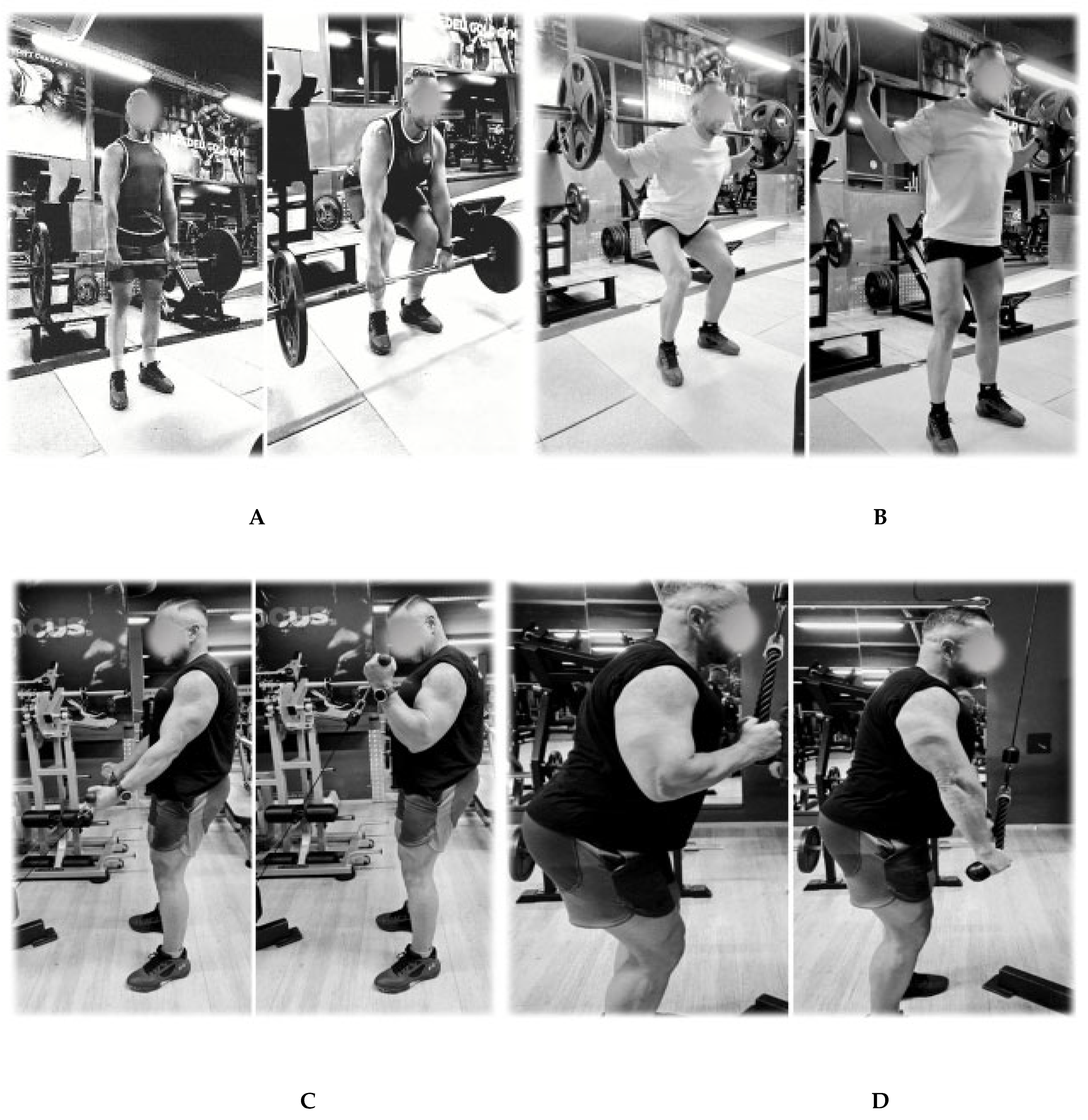
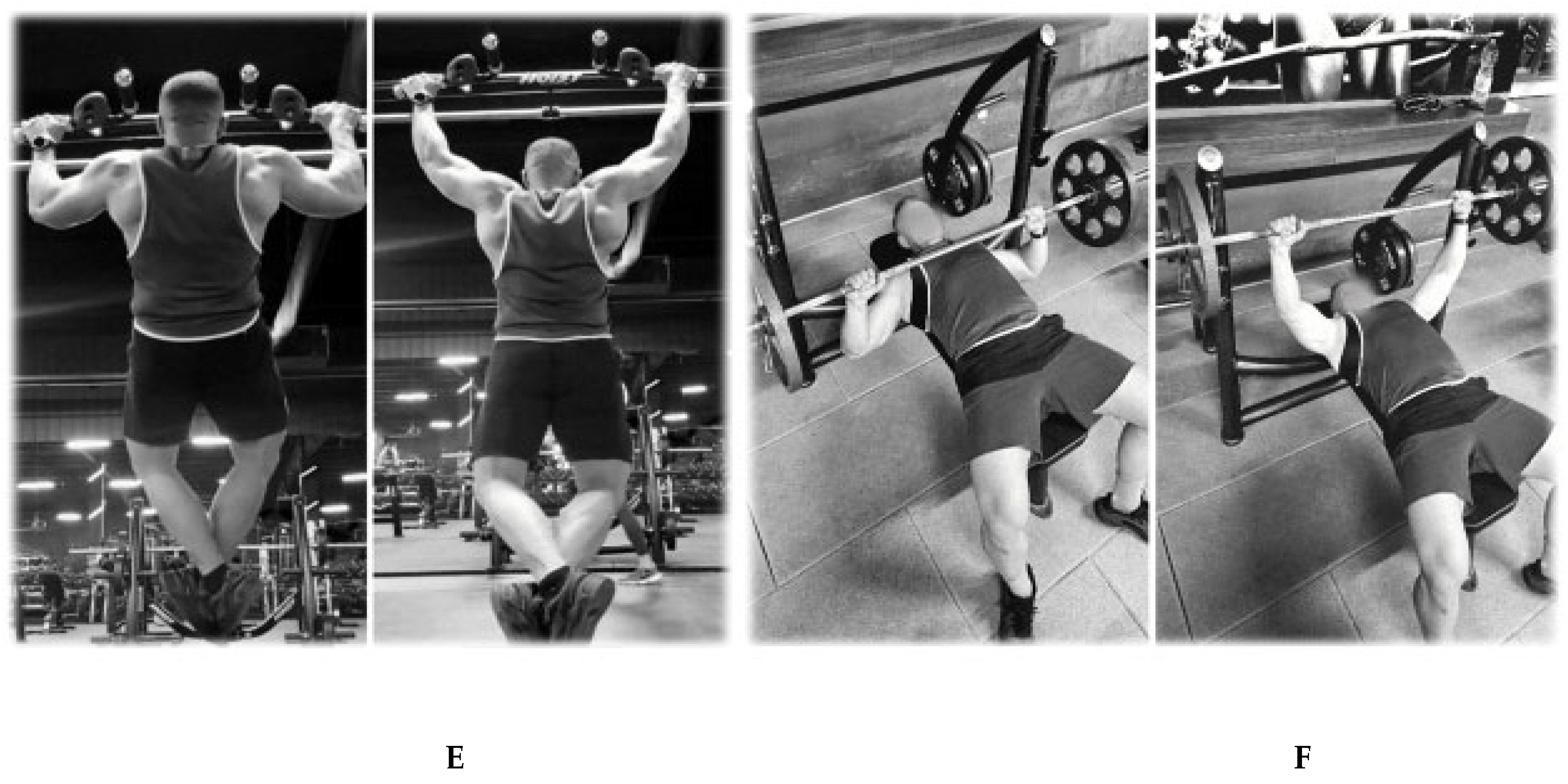
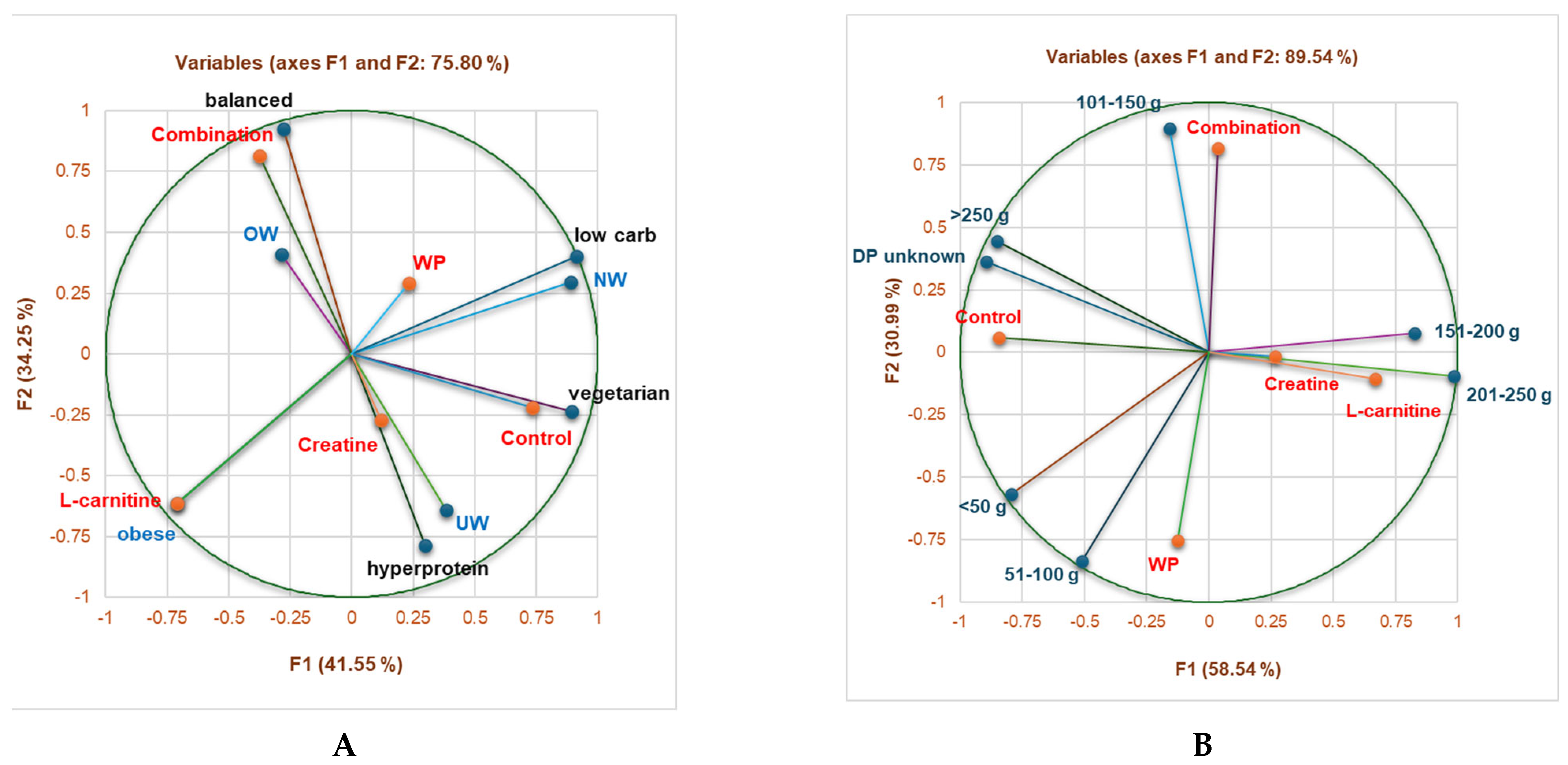
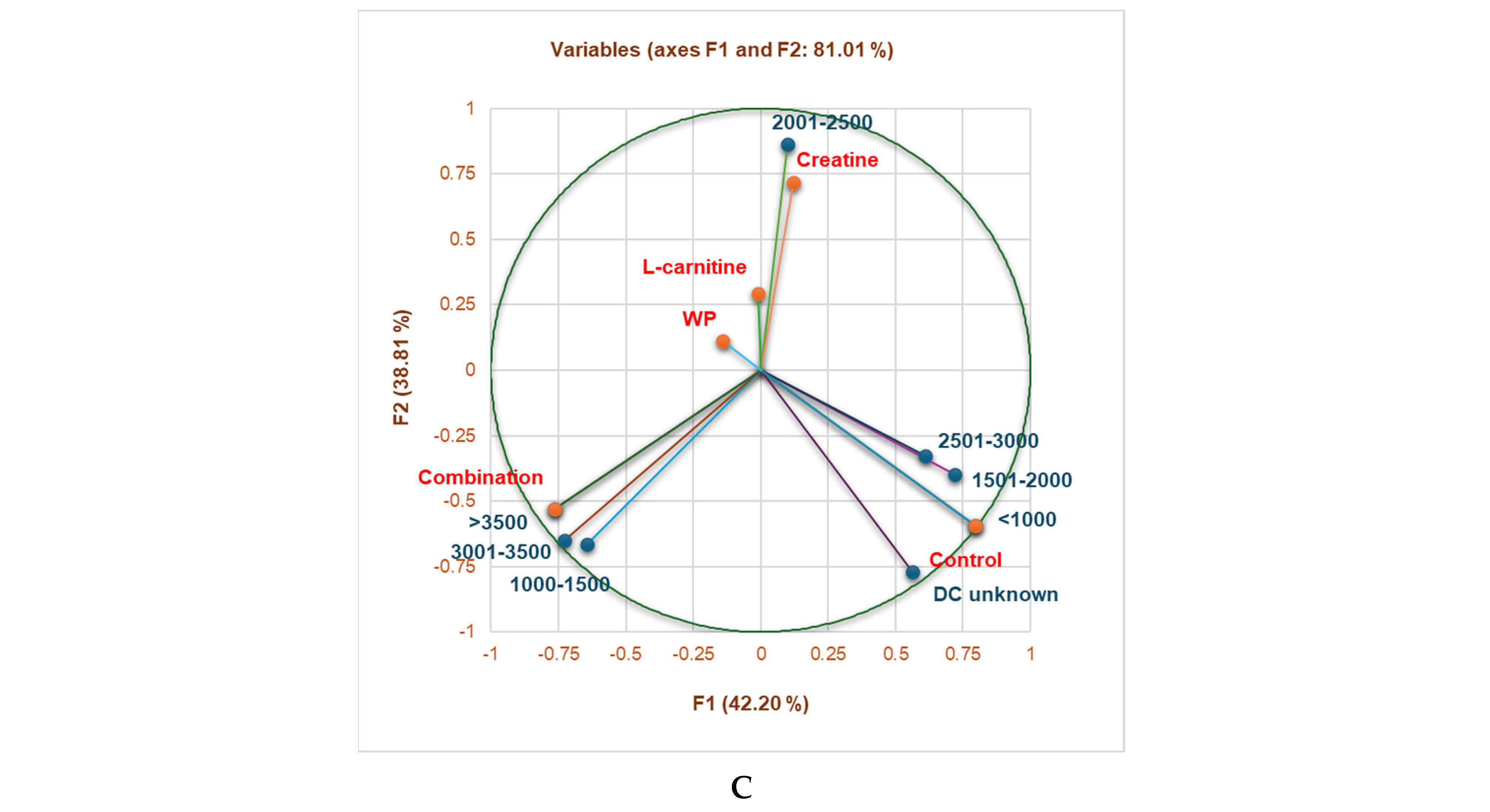
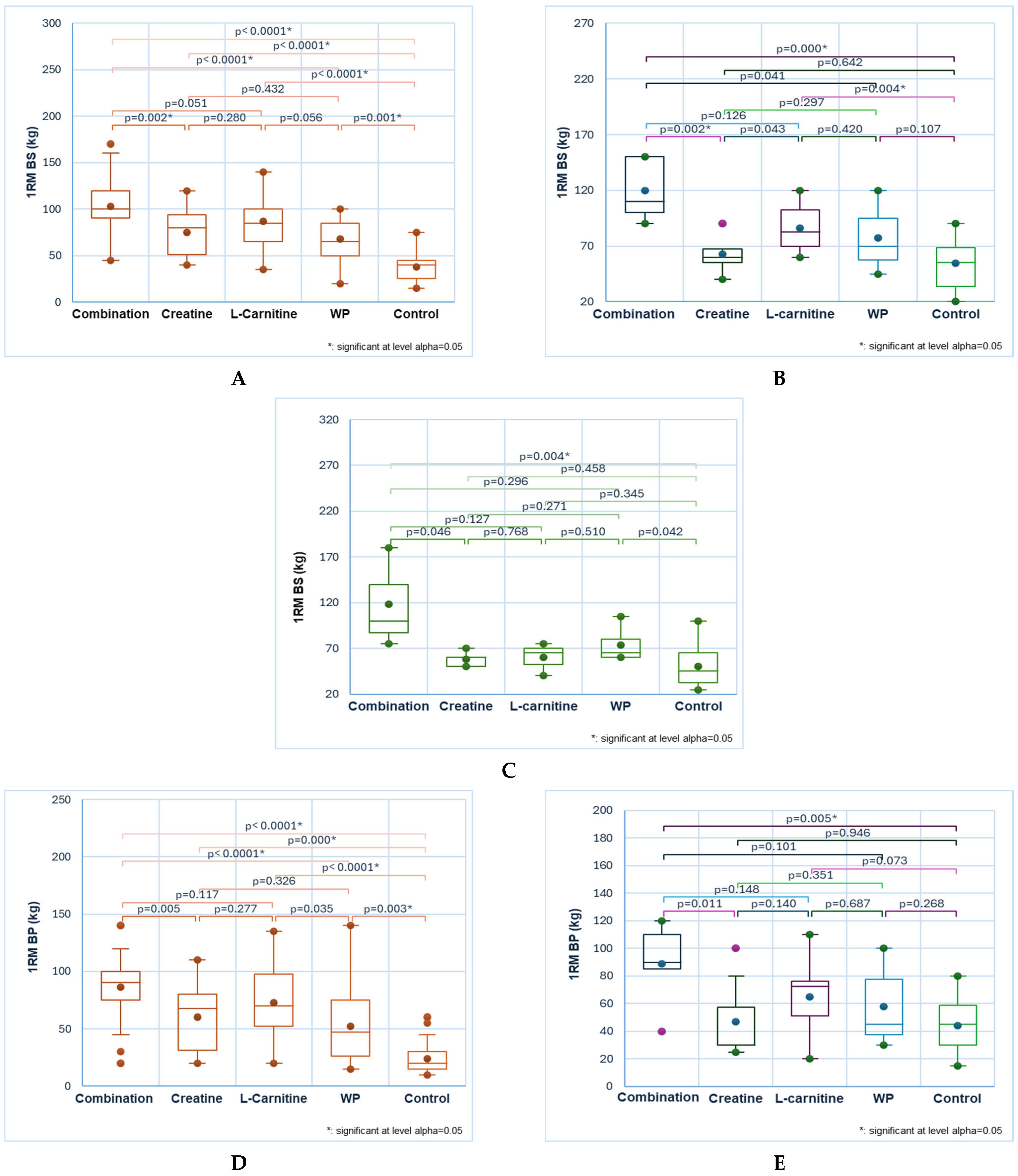

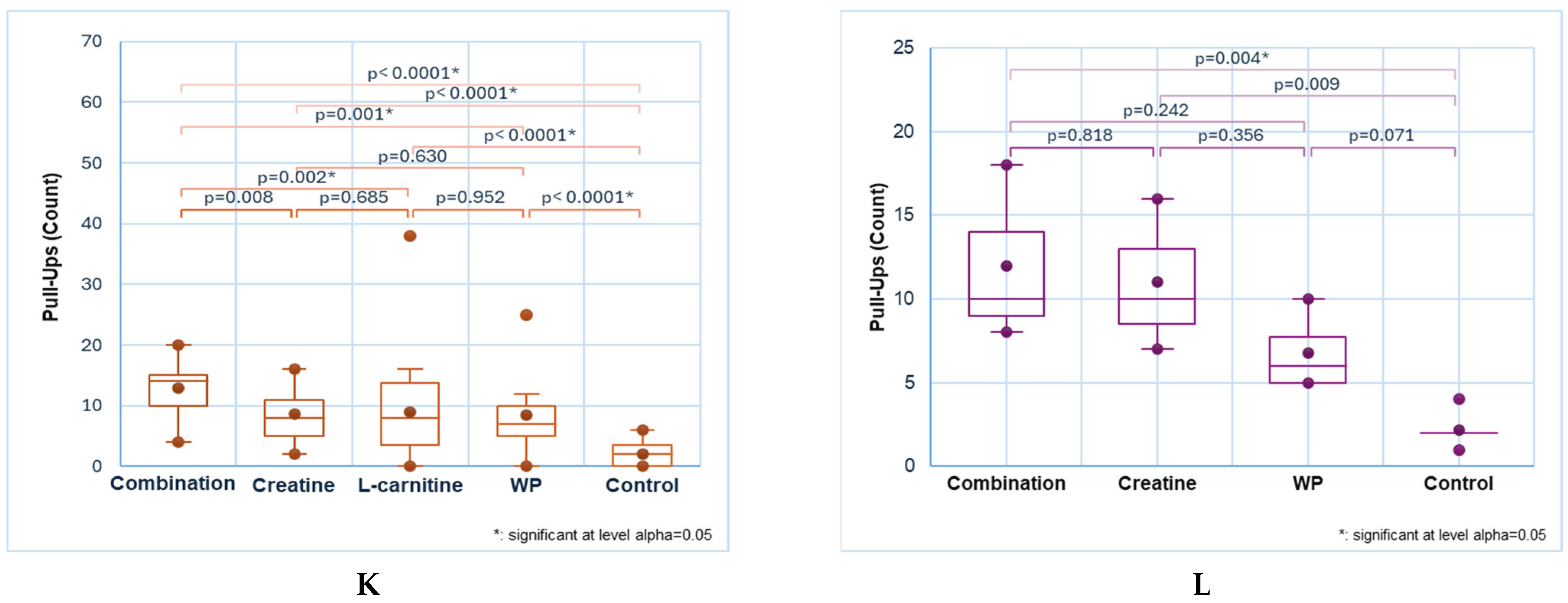
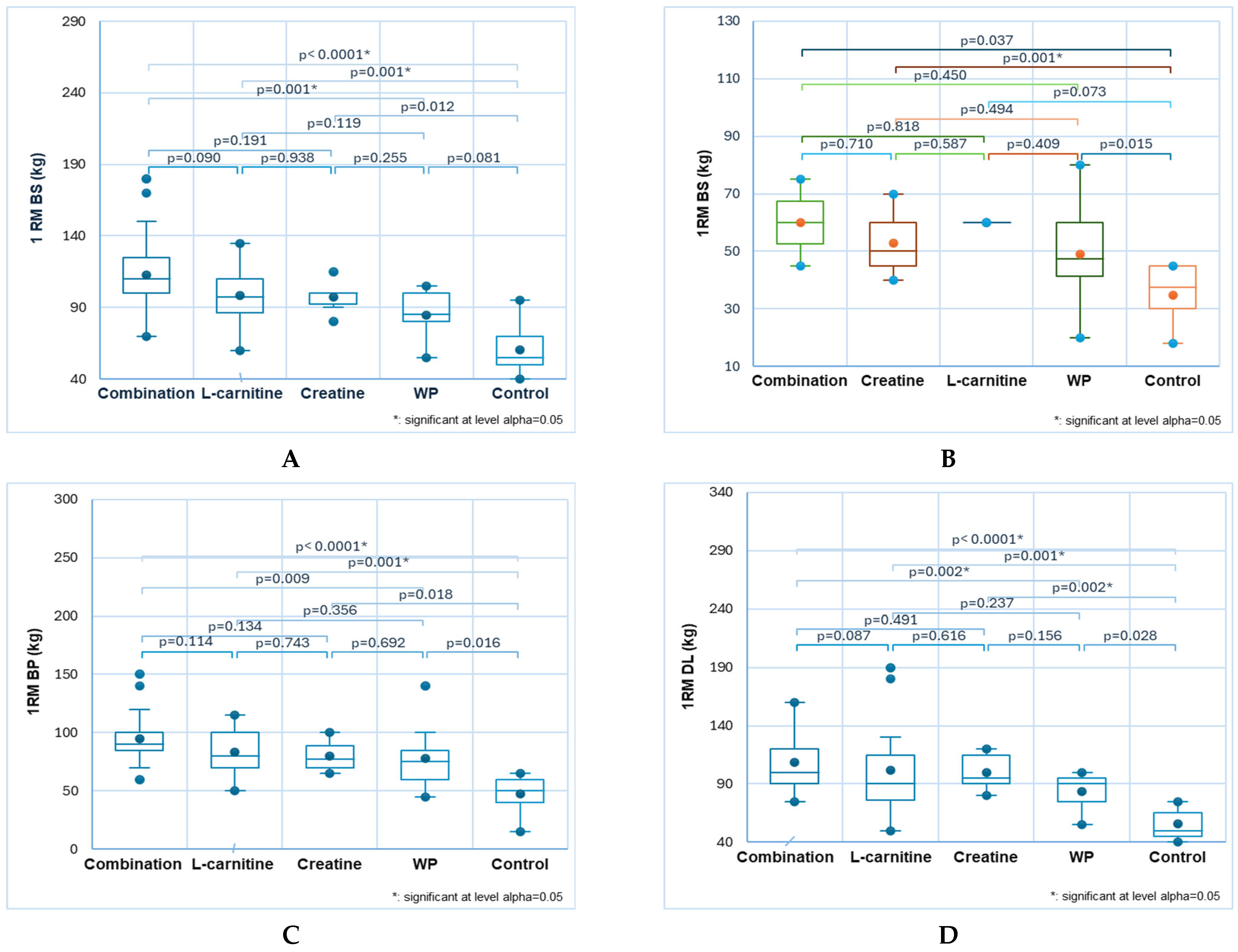
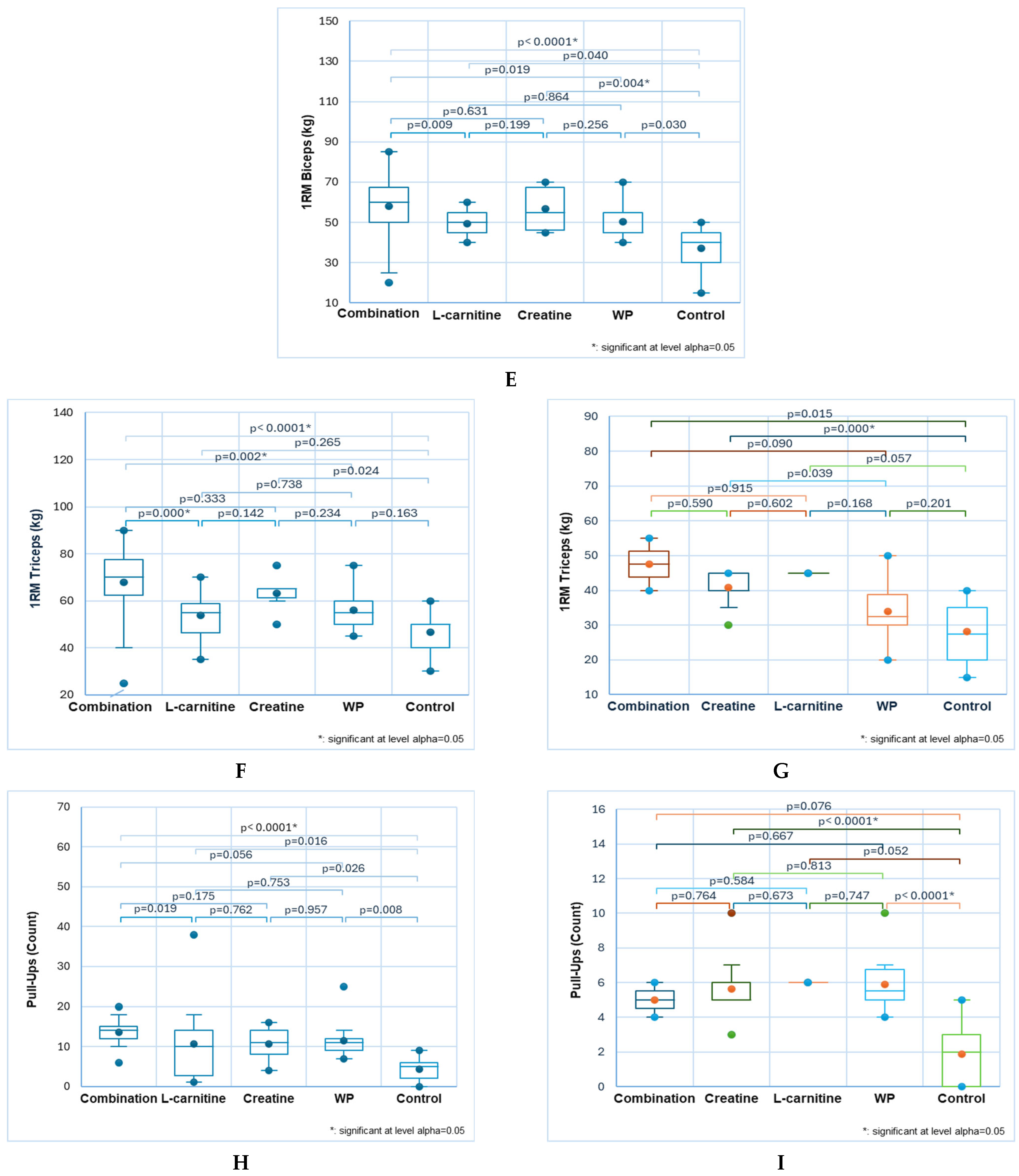
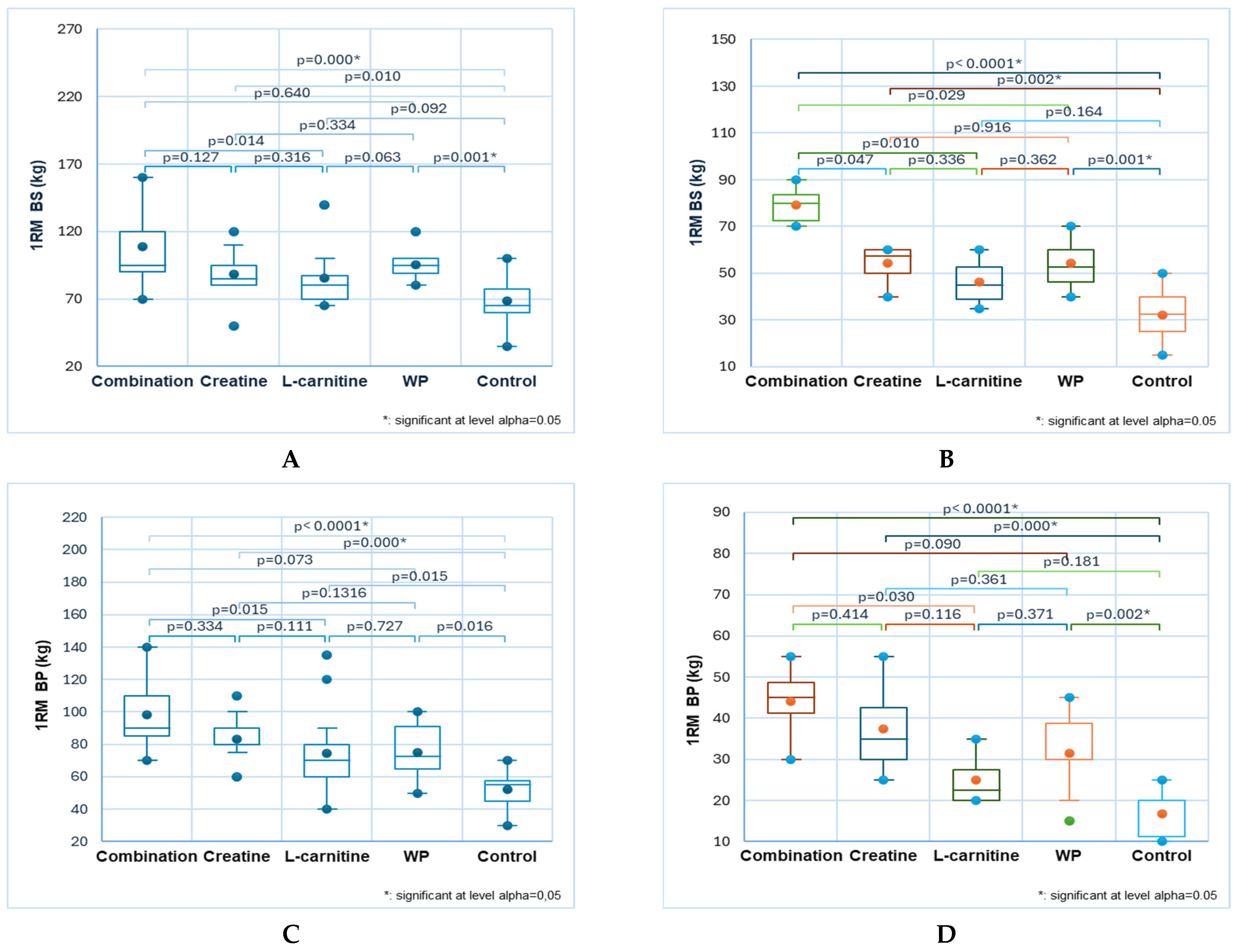
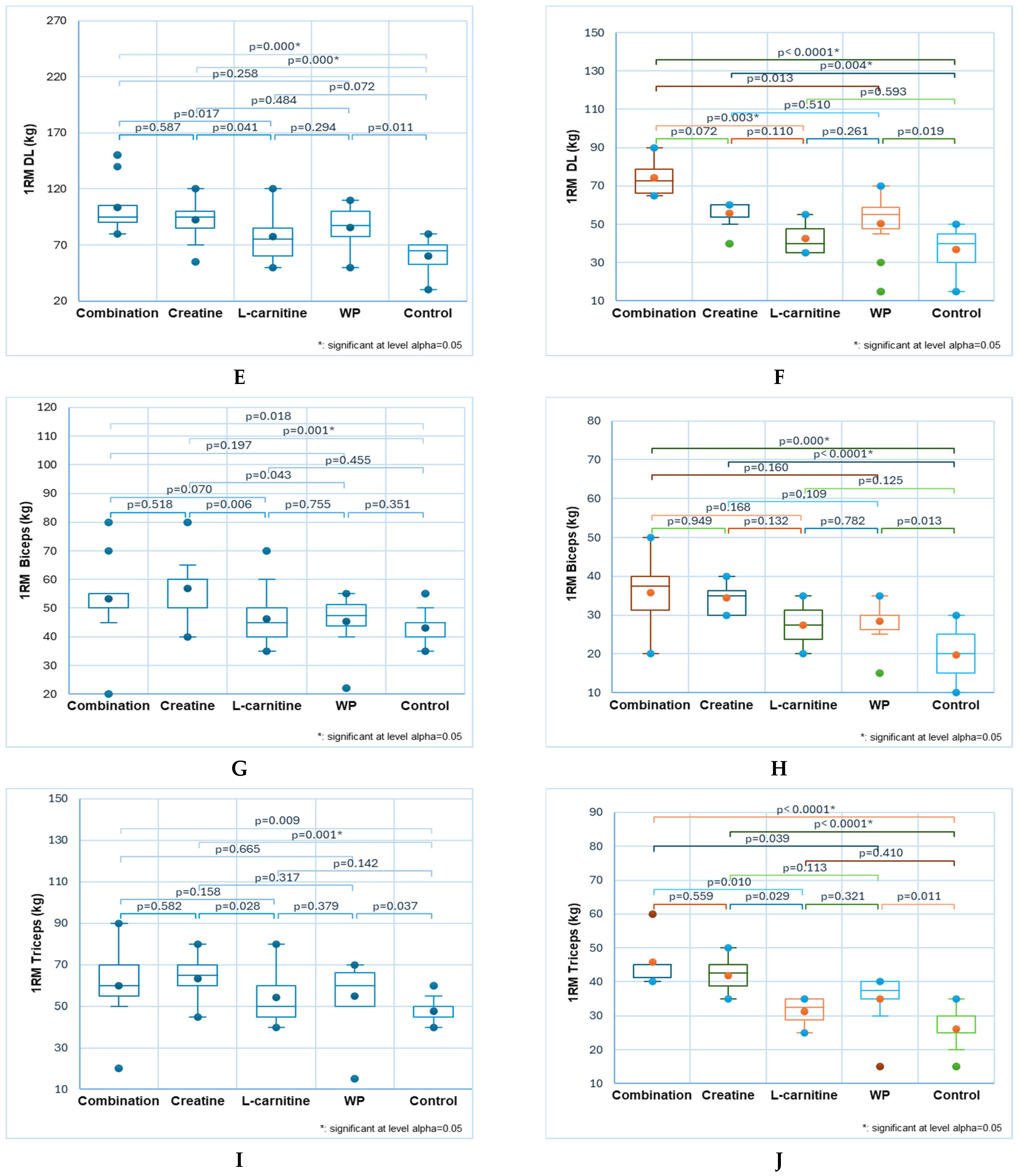

| Parameter | Total group | Female | Male | p-Value | |||
|---|---|---|---|---|---|---|---|
| n | % | n | % | n | % | ||
| Total | 218 | 100 | 86 | 39.45 | 132 | 60.55 | <0.05 |
| Age (years) | |||||||
| 18–30 | 113 | 51.83 | 40 | 46.51 | 73 | 55.30 | <0.05 |
| 31–50 | 98 | 44.95 | 42 | 48.84 | 56 | 42.42 | <0.05 |
| 51–60 | 7 | 3.21 | 4 | 4.65 | 3 | 2.27 | <0.05 |
| Body Weight Status | |||||||
| NW | 112 | 51.38 | 65 | 75.58 | 47 | 35.61 | <0.05 |
| OW | 98 | 44.95 | 16 | 18.60 | 82 | 62.12 | <0.05 |
| UW | 6 | 2.75 | 5 | 5.81 | 1 | 0.76 | <0.05 |
| obese | 2 | 0.92 | 0 | 0.00 | 2 | 1.52 | <0.05 |
| Daily Diet | |||||||
| balanced | 130 | 59.63 | 46 | 53.49 | 84 | 63.64 | <0.05 |
| hyperprotein | 46 | 21.10 | 19 | 22.09 | 27 | 20.45 | <0.05 |
| low carb | 15 | 6.88 | 6 | 6.98 | 9 | 6.82 | <0.05 |
| vegetarian | 27 | 12.39 | 15 | 17.44 | 12 | 9.09 | <0.05 |
| Daily Calories | |||||||
| 1000–1500 | 34 | 15.60 | 17 | 19.77 | 17 | 12.88 | <0.05 |
| 1501–2000 | 71 | 32.57 | 26 | 30.23 | 45 | 34.09 | <0.05 |
| 2001–2500 | 42 | 19.27 | 16 | 18.60 | 26 | 19.70 | <0.05 |
| 2501–3000 | 43 | 19.72 | 17 | 19.77 | 26 | 19.70 | <0.05 |
| 3001–3500 | 13 | 5.96 | 4 | 4.65 | 9 | 6.82 | <0.05 |
| <1000 | 1 | 0.46 | 1 | 1.16 | 0 | 0.00 | <0.05 |
| >3500 | 1 | 0.46 | 0 | 0.00 | 1 | 0.76 | <0.05 |
| DC unknown | 13 | 5.96 | 5 | 5.81 | 8 | 6.06 | <0.05 |
| Daily Proteins (grams) | |||||||
| 101–150 g | 55 | 25.23 | 18 | 20.93 | 37 | 28.03 | <0.05 |
| 151–200 g | 34 | 15.60 | 13 | 15.12 | 21 | 15.91 | <0.05 |
| 201–250 g | 29 | 13.30 | 9 | 10.47 | 20 | 15.15 | <0.05 |
| 51–100 g | 44 | 20.18 | 23 | 26.74 | 21 | 15.91 | <0.05 |
| <50 g | 2 | 0.92 | 2 | 2.33 | 0 | 0.00 | <0.05 |
| >250 g | 18 | 8.26 | 8 | 9.30 | 10 | 7.58 | <0.05 |
| DP unknown | 36 | 16.51 | 13 | 15.12 | 23 | 17.42 | <0.05 |
| NS Consumption | |||||||
| Control | 53 | 24.31 | 31 | 36.05 | 22 | 16.67 | <0.05 |
| Combination | 48 | 22.02 | 8 | 9.30 | 40 | 30.30 | <0.05 |
| WP | 42 | 19.27 | 21 | 24.42 | 21 | 15.91 | >0.05 |
| Creatine | 38 | 17.43 | 19 | 22.09 | 19 | 14.39 | >0.05 |
| L-carnitine | 37 | 16.97 | 7 | 8.14 | 30 | 22.73 | <0.05 |
| Measurement | W0 | W4 | W8 |
|---|---|---|---|
| 1 RM Back Squat (kg) | |||
| Min | 10 | 15 | 15 |
| Max | 140 | 160 | 180 |
| Mean | 56 | 66 | 75 |
| SD | 25 | 28 | 32 |
| Covariance | p-Value | ||
| Gender | <0.0001 | <0.0001 | <0.0001 |
| NS type | <0.0001 | <0.0001 | <0.0001 |
| Body weight status | <0.0001 | <0.0001 | <0.0001 |
| Daily calorie | 0.037 * | 0.052 | 0.109 |
| Daily proteins (g) | 0.040 * | 0.052 | 0.048 * |
| 1RM Bench Press (kg) | |||
| Min | 10 | 10 | 10 |
| Max | 120 | 130 | 150 |
| Mean | 43 | 51 | 59 |
| SD | 24 | 28 | 32 |
| Covariance | p-Value | ||
| Gender | <0.0001 | <0.0001 | <0.0001 |
| NS type | <0.0001 | <0.0001 | <0.0001 |
| Body weight status | <0.0001 | <0.0001 | <0.0001 |
| 1RM Deadlift (kg) | |||
| Min | 10 | 15 | 15 |
| Max | 140 | 160 | 190 |
| Mean | 54 | 65 | 74 |
| SD | 22 | 26 | 31 |
| Covariance | p-Value | ||
| Gender | <0.0001 | <0.0001 | <0.0001 |
| NS type | <0.0001 | <0.0001 | <0.0001 |
| Body weight status | <0.0001 | <0.0001 | <0.0001 |
| Age (years) | 0.234 | 0.066 | 0.013 * |
| 1RM Biceps (kg) | |||
| Min | 10 | 10 | 10 |
| Max | 60 | 70 | 85 |
| Mean | 29 | 36 | 42 |
| SD | 11 | 13 | 16 |
| Covariance | p-Value | ||
| Gender | <0.0001 | <0.0001 | <0.0001 |
| Body weight status | <0.0001 | <0.0001 | <0.0001 |
| NS type | <0.0001 | <0.0001 | <0.0001 |
| Daily proteins (g) | 0.038 * | 0.017 * | 0.013 * |
| Diet type | 0.139 | 0.075 | 0.048 * |
| 1RM Triceps (kg) | |||
| Min | 5 | 10 | 15 |
| Max | 60 | 80 | 90 |
| Mean | 34 | 43 | 49 |
| SD | 11 | 13 | 17 |
| Covariance | p-Value | ||
| Gender | <0.0001 | <0.0001 | <0.0001 |
| Body weight status | <0.0001 | <0.0001 | <0.0001 |
| NS type | <0.0001 | <0.0001 | <0.0001 |
| Daily proteins (g) | 0.012 * | 0.005 * | 0.003 * |
| Diet type | 0.154 | 0.078 | 0.025 * |
| Pull-Ups (count) | |||
| Min | 0 | 0 | 0 |
| Max | 15 | 30 | 38 |
| Mean | 4 | 6 | 8 |
| SD | 3 | 5 | 6 |
| Covariance | p-Value | ||
| Gender | <0.0001 | <0.0001 | <0.0001 |
| NS type | <0.0001 | <0.0001 | <0.0001 |
| Diet type | 0.018 * | 0.022 * | 0.018 * |
| Body weight status | 0.041 * | 0.105 | 0.125 |
| Age (years) | 0.228 | 0.026 * | 0.012 * |
| NS Type | Body Weight Status—Measurement Time | Minimum Weight | Maximum Weight | Mean | Std. Deviation | * p-Value |
|---|---|---|---|---|---|---|
| Combination | NW—W0 | 46 | 85 | 70 | 10 | <0.05 |
| NW—W8 | 50 | 88 | 72 | 10 | ||
| OW—W0 | 68 | 132 | 91 | 13 | ||
| OW—W8 | 65 | 130 | 92 | 13 | ||
| Creatine | NW—W0 | 49 | 90 | 66 | 11 | <0.05 |
| NW—W8 | 53 | 93 | 68 | 10 | ||
| OW—W0 | 70 | 108 | 89 | 11 | ||
| OW—W8 | 74 | 114 | 92 | 12 | ||
| WP | NW—W0 | 47 | 92 | 67 | 11 | <0.05 |
| NW—W8 | 49 | 97 | 67 | 12 | ||
| OW—W0 | 71 | 124 | 92 | 13 | ||
| OW—W8 | 71 | 120 | 93 | 12 | ||
| Control | NW—W0 | 45 | 88 | 59 | 10 | <0.05 |
| NW—W8 | 47 | 83 | 58 | 10 | ||
| OW—W0 | 56 | 128 | 87 | 19 | ||
| OW—W8 | 57 | 123 | 85 | 19 | ||
| L—carnitine | NW—W0 | 50 | 81 | 67 | 11 | <0.05 |
| NW—W8 | 49 | 80 | 64 | 10 | ||
| OW—W0 | 66 | 113 | 90 | 13 | ||
| OW—W8 | 64 | 106 | 86 | 12 | ||
| obese—W0 | 130 | 130 | 130 | 0 | ||
| obese—W8 | 122 | 124 | 123 | 1 |
| Age | 18–30 | 31–50 | 51–60 | |||
|---|---|---|---|---|---|---|
| Sex | F | M | F | M | F | M |
| Body weight status | ||||||
| NW | 75.00 | 46.58 | 78.57 | 23.21 | 50.00 | 0.00 |
| OW | 15.00 | 49.32 | 19.05 | 76.79 | 50.00 | 100.00 |
| UW | 10.00 | 1.37 | 2.38 | 0.00 | 0.00 | 0.00 |
| obese | 0.00 | 2.74 | 0.00 | 0.00 | 0.00 | 0.00 |
| Diet type | ||||||
| balanced | 47.50 | 63.01 | 64.29 | 64.29 | 0.00 | 66.67 |
| hyperprotein | 25.00 | 17.81 | 19.05 | 23.21 | 25.00 | 33.33 |
| low carb | 5.00 | 9.59 | 7.14 | 3.57 | 25.00 | 0.00 |
| vegetarian | 22.50 | 9.59 | 9.52 | 8.93 | 50.00 | 0.00 |
| NS type | ||||||
| Combination | 5.00 | 42.47 | 14.29 | 16.07 | 0.00 | 0.00 |
| Control | 40.00 | 12.33 | 33.33 | 19.64 | 25.00 | 66.67 |
| Creatine | 27.50 | 8.22 | 19.05 | 23.21 | 0.00 | 0.00 |
| L-carnitine | 2.50 | 19.18 | 9.52 | 26.79 | 50.00 | 33.33 |
| WP | 25.00 | 17.81 | 23.81 | 14.29 | 25.00 | 0.00 |
| Impact | Age (Years) | Body Weight Status | Diet Type | Daily Calories | Daily Proteins (g) | NS Type |
|---|---|---|---|---|---|---|
| Males | ||||||
| p-value | <0.0001 | <0.0001 | 0.042 | 0.001 | 0.038 | <0.0001 |
| Females | ||||||
| p-value | 0.014 | <0.0001 | 0.028 | 0.065 * | 0.001 | <0.0001 |
Disclaimer/Publisher’s Note: The statements, opinions and data contained in all publications are solely those of the individual author(s) and contributor(s) and not of MDPI and/or the editor(s). MDPI and/or the editor(s) disclaim responsibility for any injury to people or property resulting from any ideas, methods, instructions or products referred to in the content. |
© 2025 by the authors. Licensee MDPI, Basel, Switzerland. This article is an open access article distributed under the terms and conditions of the Creative Commons Attribution (CC BY) license (https://creativecommons.org/licenses/by/4.0/).
Share and Cite
Nagy, S.-R.; Mititelu, M.; Marin, R.-C.; Popovici, V.; Pallag, A.; Jurca, T. The Impact of Protein and Amino Acid Supplementation on Muscular Strength and Endurance in Recreational Gym-Goers During 8-Week Resistance Training. Sports 2025, 13, 182. https://doi.org/10.3390/sports13060182
Nagy S-R, Mititelu M, Marin R-C, Popovici V, Pallag A, Jurca T. The Impact of Protein and Amino Acid Supplementation on Muscular Strength and Endurance in Recreational Gym-Goers During 8-Week Resistance Training. Sports. 2025; 13(6):182. https://doi.org/10.3390/sports13060182
Chicago/Turabian StyleNagy, Sandor-Richard, Magdalena Mititelu, Ruxandra-Cristina Marin, Violeta Popovici, Annamaria Pallag, and Tünde Jurca. 2025. "The Impact of Protein and Amino Acid Supplementation on Muscular Strength and Endurance in Recreational Gym-Goers During 8-Week Resistance Training" Sports 13, no. 6: 182. https://doi.org/10.3390/sports13060182
APA StyleNagy, S.-R., Mititelu, M., Marin, R.-C., Popovici, V., Pallag, A., & Jurca, T. (2025). The Impact of Protein and Amino Acid Supplementation on Muscular Strength and Endurance in Recreational Gym-Goers During 8-Week Resistance Training. Sports, 13(6), 182. https://doi.org/10.3390/sports13060182









